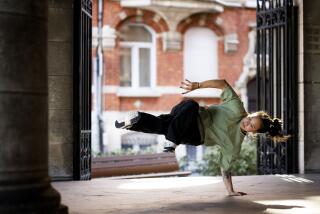What’s the Point?
- Share via
GRANADA HILLS — Bonnie Kipper forgot--and aimed at her 12-year-old son, Doron, with her sword.
“Our goal is to miss,” said teacher Roberta Brown.
In the swashbuckling class at the North Valley Jewish Community Center, students might come in with images of Errol Flynn as Robin Hood jumping over tables and swinging from ropes.
But in reality, Brown said, swashbuckling involves memorizing a variety of movements, and although filmed sword fights appear fast and dangerous, they take a long time to plan.
The most important lesson in her class, Brown said, is safety. Unlike fencing, where the goal is to swiftly hit the opponent, students in this swashbuckling class are not allowed to strike each other.
“In fencing, one doesn’t know where the next move is going to go,” said Mark Ryan, a sword master and choreographer who is co-writing a book about swashbuckling films. “We actually choreograph the fight so each person knows where the next thrust is coming from. You want it to look as stylish and pretty as you can.”
In Brown’s swashbuckling class--part of the Jewish Community Center of Fine Arts program--combatants never point their weapons at each other and only aim near an opponent’s arms or hips. Although the thin, lightweight blades are dull and have flat tips, they can still cause injury. Students maneuver slowly and their moves are pronounced.
“We make moves more dramatic to tell a story,” said Brown, 34, a choreographer and sword combat instructor from Santa Monica, who also teaches a beginning fencing class in Culver City.
The term swashbuckling can be traced to shields, called bucklers, carried by swaggering swordsmen several centuries ago, Ryan said. Their swords made a swashing sound when they clashed against the shields. Choreographed combat has existed for more than 300 years, he said.
Students in Brown’s class--which starts a new session Monday--said they enrolled because they wanted to learn what lies behind the flash and flair of swashbuckling.
Philip Baron and his 7-year-old son, Sam, enrolled in the class because the boy enjoys playing with plastic swords at home, Baron said. Father and son work on their technique by analyzing sword fights in slow motion in films such as “The Princess Bride.” They especially enjoy faking death or injury.
“It’s a little more serious than I thought it would be,” said Baron, 39, of Northridge. “It’s what’s actually taught in Hollywood to actors. It’s the real thing.”
Brown, who also acts, began her stage combat training in London and started teaching actors to use swords a decade ago. Then, six months ago, she began teaching swashbuckling to children at several schools, but she conceded she had some reservations about it.
“I didn’t think I’d be able to trust this many kids holding swords, running around,” she said.
As a precaution, she starts children off with plastic tubes covered with foam.
“If they’re waving it around and poking each other they don’t get a real sword that day,” she said.
In class, students learn some history of sword combat and improve their hand-eye coordination. For kids brought up with violence on TV and in video games, Brown demystifies staged sword fights.
“I really try to stress for them that movies aren’t real,” Brown said. “It’s an opportunity for them to make fun of it, to see how it’s really done.”
Theatrical sword combat also teaches discipline because it takes a long time to master, Ryan said.
“Like with any sport, you have to accumulate an amount of [skill] to be good at it, and it’s a very cool thing to be good at,” said Ryan, 43, of North Hollywood.
Yet some moms and dads are not always sure about their kids becoming swashbucklers.
“Some parents have said, ‘Is this safe?’ or ‘Why is my child learning this?’ ” Brown said. “It’s good for them to have something in the day that stresses safety that much and allows them to take some responsibility. I’d like to think that carries to other parts of their lives.”
Brown and Ryan belong to a small world of about a dozen sword choreography experts in Los Angeles who work with actors on stages and with stunt coordinators on film sets. Although Brown, one of the few women in this specialized field, teaches her skill in an age of high-powered firearms, she said learning to use a sword is worthwhile and relevant.
“This is a skill that has a history, a tradition, honor,” she said. “I try getting them young to give them this message: Guns are for cowards.”
At the end of a recent class, Brown played the first movement of Carl Orff’s “Carmina Burana” and handed out real swords to the class’ six students.
“I don’t want to see any tips touching people,” Brown said. “Tips to the ground until your fight comes up.”
A new swashbuckling class begins Monday at the Jewish Community Center. Classes are $108 for members and $140 for nonmembers. For information, call (818) 360-2211.
More to Read
Go beyond the scoreboard
Get the latest on L.A.'s teams in the daily Sports Report newsletter.
You may occasionally receive promotional content from the Los Angeles Times.










